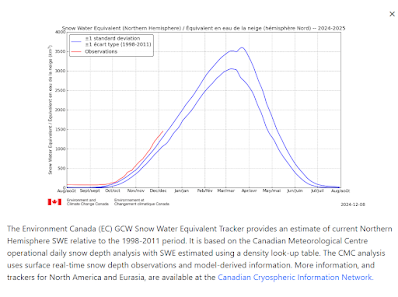Introduction
This winter is, according to the UN's own data, the fifth winter running with snow and ice accumulating on the northern hemisphere.
 |
| Snow and Ice accumulation 2024 to 2025 |
We're more than one standard deviation above normal compared to winters from 1998 to 2011.
Increase in glaciation
It's also clear from the above graph that the snow and ice accumulated during the winter of 2023 to 2024 did not melt away through the summer, because the red line starts above zero. The northern hemisphere is in other words seeing an increase in ice cover.
Looking at the winter of 2023 to 2024 we see that it too started out with glaciation.
 |
| Snow and Ice accumulation 2023 to 2024 |
So, if this winter follows this trend, we will see further glaciation into next year.
Greenland is accumulating ice
From this, it's also clear that Greenland cannot possibly be shedding its icecap, because Greenland has by far the thickest ice cover on the northern hemisphere. If it was melting away at anywhere near the pace reported in mainstream media, it would show up as deglaciation on the above two graphs, which is the opposite of what we're seeing.
This is of particular interest to us because there's absolutely no chance of the South Pole loosing any significant amount of ice. Any melting down there happens out at sea, which doesn't affect sea levels, or at the outer fringes of its landmass, which amounts to very little of Antarctica's total ice cover.
Antarctica is too cold for deglaciation
The bulk of Antarctica's ice is located in areas that never see temperatures above freezing. Even if temperatures were to rise well above what they are today, Antarctica will remain unaffected. It may even accumulate more ice due to increased precipitation.
Greenland, on the other hand, is located at a latitude that would see deglaciation if it wasn't for a cold ocean current coming down from the North Pole, which keeps the area colder than what it would otherwise be.
A change in ocean currents would cause Greenland's ice to melt. However, that would be at the expense of Scandinavia, which would see its climate go from unusually mild, considering its location, to unusually cold.
As far as climate goes, Greenland and Scandinavia can swap places, but they cannot both become significantly warmer at the same time. A small temperature increase is all we can reasonably expect to see for both these regions at the same time.
Worst case scenario
This means that any rise in sea levels would have to come from Greenland. But that icesheet isn't going to melt very fast. It will take centuries, if not millennia to melt it all, and the resulting sea rise will be no more than 7.4 meters.
So, if we for argument's sake suppose that it will take 740 years to melt all of the ice on Greenland, we'll get a 10 millimeter sea rise per year, which translates to one meter per century.
However, there is at the moment no deglaciation going on. In fact, there's more ice on the northern hemisphere today than there was fifteen years ago, so a ten millimeter sea rise per year is an absolute worst case, at least for this coming century.
Conclusion
Considering that there's no deglaciation going on at the moment, and that even a worst case scenario limits sea rise to one meter per century, there's no reason for anyone to panic about rising sea levels.
A modest investment in dikes and water management infrastructure is all that's required in order to fully protect ourselves for at least a century into the future.
No comments:
Post a Comment